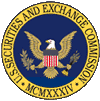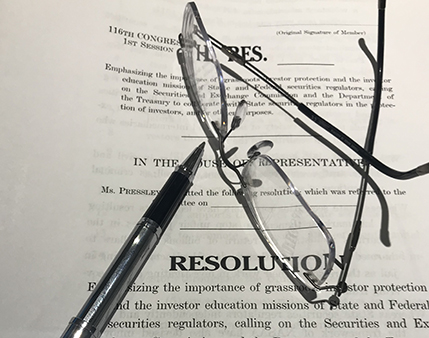

SEPTEMBER 28, 2011 — The SEC’s Office of Investor Education and Advocacy (OIEA) and the North American Securities Administrators Association (NASAA) are issuing this Investor Alert to warn investors of the potential risks associated with investing through self-directed Individual Retirement Accounts (self-directed IRAs).
NASAA has noted a recent increase in reports or complaints of fraudulent investment schemes that utilized a self-directed IRA as a key feature. State securities regulators have investigated numerous cases where a self-directed IRA was used in an attempt to lend credibility to a fraudulent scheme. Similarly, the SEC has brought numerous cases in which promoters of fraudulent schemes steered investors to self-directed IRAs.
While self-directed IRAs can be a safe way to invest retirement funds, investors should be mindful of potential fraudulent schemes when considering a self-directed IRA. Investors should understand that the custodians and trustees of self-directed IRAs may have limited duties to investors, and that the custodians and trustees for these accounts will generally not evaluate the quality or legitimacy of an investment and its promoters.
As with every investment, investors should undertake their own evaluation of the merits of a proposal, and should check with regulators about the background and history of an investment and its promoters before making a decision.
Investing through Self-Directed IRAs
An Individual Retirement Account (IRA) is a form of retirement account that provides investors with certain tax benefits for retirement savings. Some common examples of IRAs used by investors include the traditional IRA, Roth IRA, Simplified Employee Pension (SEP) IRA, and Savings Incentive Match Plan for Employees (SIMPLE) IRA. All IRA accounts are held for investors by custodians or trustees. These may include banks, trust companies, or any other entity approved by the Internal Revenue Service (IRS) to act as a trustee or custodian.
A self-directed IRA is an IRA held by a trustee or custodian that permits investment in a broader set of assets than is permitted by most IRA custodians. Most IRA custodians are banks and broker-dealers that limit the holdings in IRA accounts to firm-approved stocks, bonds, mutual funds and CDs. Custodians and trustees for self-directed IRAs, however, may allow investors to invest retirement funds in other types of assets such as real estate, promissory notes, tax lien certificates, and private placement securities. While self-directed IRAs may offer investors access to an array of private investment opportunities that are not available through other IRA providers, investments in these kinds of assets may have unique risks that investors should consider. Those risks can include a lack of disclosure and liquidity — as well as the risk of fraud.
Self-Directed IRAs and the Risk of Fraud
According to a 2011 report by the Investment Company Institute, U.S. investors held approximately $4.7 trillion in IRAs. Estimates from various sources approximate that investors’ hold 2 percent, or $94 billion, of IRA retirement funds in self-directed IRAs. The large amount of money held in self-directed IRAs makes them attractive targets for fraud promoters. Fraud promoters also may target other types of retirement accounts by attempting to lure investors into transferring money from those accounts to new self-directed IRAs in order to participate in the fraud promoter’s scheme.
In particular, fraud promoters who want to engage in Ponzi schemes or other fraudulent conduct may exploit self-directed IRAs because they permit investors to hold unregistered securities and the custodians or trustees of these accounts likely have not investigated the securities or the background of the promoter. There are a number of ways that fraud promoters may use these weaknesses and misperceptions to perpetrate a fraud on unsuspecting investors. For example:
- Misrepresentations Regarding Custodial Responsibilities – Fraud promoters can misrepresent the responsibilities of self-directed IRA custodians to deceive investors into believing that their investments are legitimate or protected against losses. Fraud promoters often state or suggest that self-directed IRA custodians investigate and validate any investment in a self-directed IRA. Self-directed IRA custodians are responsible only for holding and administering the assets in a self-directed IRA. They generally do not evaluate the quality or legitimacy of any investment in the self-directed IRA or its promoters. Furthermore, most custodial agreements between a self-directed IRA custodian and an investor explicitly state that the self-directed IRA custodian has no responsibility for investment performance.
- Exploitation of Tax-Deferred Account Characteristics – Self-directed IRAs are tax-deferred retirement accounts that carry a financial penalty for prematurely withdrawing money before a certain age. This financial penalty may induce self-directed IRA investors to keep funds in a fraudulent scheme longer than those investors who invest through other means. Also, the prospect of an early withdrawal penalty could encourage an investor to become passive with a lesser degree of oversight than a managed account might receive, allowing a fraud promoter to perpetrate his fraud longer.
- Lack of Information for Alternative Investments – Self-directed IRAs usually allow investors to hold alternative investments such as real estate, mortgages, tax liens, precious metals, and private placement securities. Unlike publicly-traded securities, financial and other information necessary to make a prudent investment decision may not be as readily available for these alternative investments. Even when financial information for these alternative investments is available, it may not be audited. Furthermore, self-directed IRA custodians usually do not investigate the accuracy of this financial information. This lack of available information for alternative investments makes them a popular tool for fraud promoters’ schemes.
Ways to Avoid Fraud with Self-Directed IRAs
Verify information in self-directed IRA account statements. Alternative investments may be illiquid and difficult to value. As a result, self-directed IRA custodians often list the value of the investment as the original purchase price, the original purchase price plus returns reported by the promoter, or a price provided by the promoter. You should be aware that none of these valuations necessarily reflects the price at which the investment could be sold, if at all.
Avoid unsolicited investment offers. Investors should be very careful when they receive an unsolicited investment offer. Whether from a total stranger or from a friend, trusted co-worker, or even family member, investors should ask themselves, “Why would anyone tell me about a really great investment opportunity?” Investors also should be especially wary of an unsolicited investment offer that promotes the use of a self-directed IRA. As noted above, fraud promoters may attempt to lure investors into transferring money from traditional IRAs and other retirement accounts into new self-directed IRAs in order to participate in the fraud promoter’s scheme.
Ask questions. Always ask if the person offering the investment is licensed and if the investment is registered, then check out the answers with an unbiased source, such as the SEC or your state securities regulator. The SEC has a short publication called “Ask Questions” that discusses many of the other questions investors should ask of anyone who wants them to make an investment. Please take a look at it before making any investment decision.
Be mindful of “guaranteed” returns. Every investment carries some degree of risk, and the level of risk typically correlates with the return an investor can expect to receive. Low risk generally means low yields, and high yields typically involve higher risk. Fraud promoters often spend a lot of time trying to convince investors that extremely high returns are “guaranteed” or “can’t miss.” Don’t believe it. High returns represent potential rewards for investors who are willing and financially able to take big risks.
Ask a professional. For complex investment opportunities, particularly those which involve the opening or creation of a new account outside a traditional financial institution or well-recognized broker, investors should consider getting a second opinion from a licensed unbiased investment professional or an attorney.
Recent Cases Involving Self-Directed IRAs
Some recent examples of SEC and state enforcement cases that involve funds from self-directed IRAs invested in fraudulent schemes include:
SEC v. United American Ventures
The SEC filed charges alleging that two companies and four individuals misrepresented and concealed numerous material facts in connection with the offer and sale of $10 million in bonds to approximately 100 individual investors in various states. In particular, the SEC alleged that the defendants promised guaranteed returns in purported investments in medical technologies and raised money by convincing investors to invest through self-directed IRAs and steering them to custodians who offered the self-directed IRAs. Approximately $3.5 million of the funds invested in the bonds came from self-directed IRAs.
The SEC filed charges alleging that an individual perpetrated an offering fraud and Ponzi scheme in which at least $16 million was raised from more than 140 investors. In particular, the SEC alleged that the defendant promised “safe and risk free” returns in purported investments in real estate and commercial mortgage loans. The defendant raised money by targeting, among others, investors in self-directed IRAs. Approximately $9.2 million of the funds invested in the fraudulent scheme came from self-directed IRAs.
The SEC filed charges alleging that a company and its partners perpetrated a Ponzi scheme in which at least $20 million was raised from more than 120 investors. In particular, the SEC alleged that the defendants promised safe, guaranteed returns in purported investments in foreign bonds and raised money by convincing investors to invest in self-directed IRAs and steering them to custodians who offered the self-directed IRAs. Self-directed IRAs accounted for $20 million of the funds invested in the fraudulent scheme.
State v. Smith (24C02-1102-FB-00044) and State v. Snelling (24C02-1102-FB-00046) (Indiana)
Indiana state securities regulators pursued an action alleging that Jerry Smith and Jasen Snelling bilked investors out of more than $4.5 million in a nearly decade-long Ponzi scheme where Mr. Smith and Mr. Snelling told investors they were talented day traders and promised up to 20 percent returns. Mr. Smith and Mr. Snelling, through various companies, encouraged investors to roll over their traditional IRA accounts into self-directed IRAs at a trust company. Mr. Smith and Mr. Snelling would immediately take the funds from those accounts and use them for personal living expenses, but investors continued to receive statements from the trust company, as well as bills for custodial fees, even after their money was taken out of the accounts. Mr. Smith and Mr. Snelling are charged with more than fifty counts of violations of the Indiana Uniform Securities Act.
In re: Stephen Edward Gwin, et al. (Missouri)
Missouri state securities regulators issued final orders against Stephen Gwin in two separate cases where Mr. Gwin, a federal felon, and others misled senior citizens into investing in unregistered securities, and diverting investment proceeds through self-directed IRAs at trust companies into accounts that Mr. Gwin controlled. Mr. Gwin promoted his million-dollar scam through free-lunch investment seminars. Mr. Gwin and his co-respondents were found liable and ordered to pay various civil penalties.
Texas v. Warr Investment Group, LLC, et al. (Texas)
Texas state securities regulators filed a petition alleging that James Elton Warr through Warr Investment Group LLC and other entities encouraged investors to transfer their funds to a self-directed IRA that was not independent, but instead was secretly controlled by his daughter. According to the petition, the Warr entities defrauded the public through their illegal and deceptive sales of securities in real estate investment programs. Mr. Warr claimed that investors would receive a guaranteed 8 percent annual return and that the real estate investments were a safe and lucrative alternative to more traditional investments such as certificates of deposit and stocks. Mr. Warr and his entities raised at least $970,000 from 30 investors. A Texas court granted the Texas State Securities Board request to freeze Mr. Warr’s assets and appoint a receiver to take control of Warr Investment Group LLC and its related entities.
Recourse for Fraud Victims
If you have lost money in a fraudulent investment or scheme involving a self-directed IRA or a third-party custodian or trustee, or have information about one of these scams, you should contact:
- The SEC Complaint Center.
- Your state’s securities administrator. You can find links and addresses for your state regulator by visiting the North American Securities Administrators Association’s website.
You also can check the SEC’s Investor Claims Fundswebpage for information concerning the appointment of a receiver or claims administrator in any SEC enforcement action.
Related Information
For additional educational information for investors, see the SEC’s Office of Investor Education and Advocacy’s homepage, or NASAA’s investor education webpage.
For additional information related to avoiding fraud, also see:
For additional information regarding IRAs, please see the Internal Revenue Service’s IRA Online Resource Guide.











